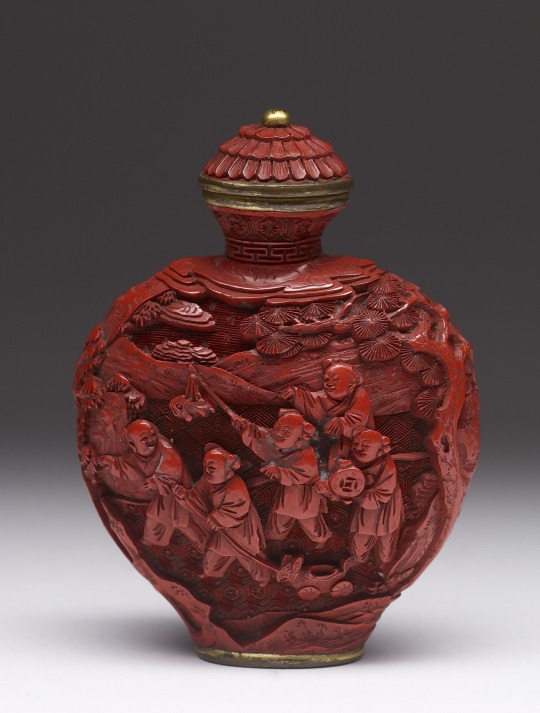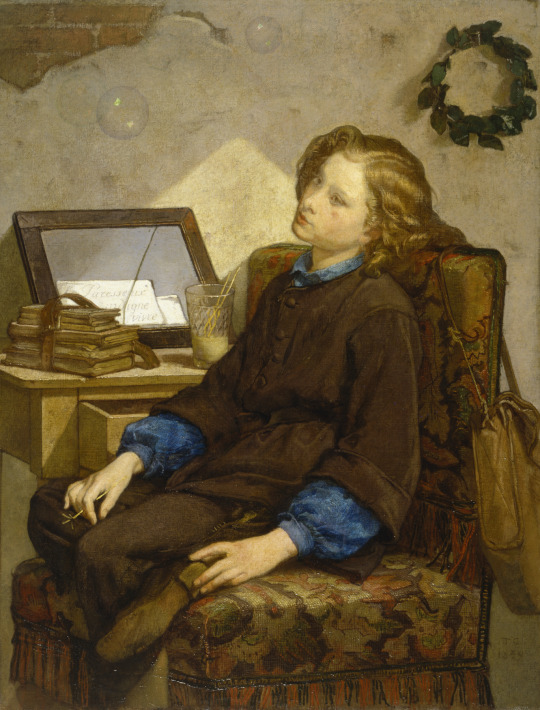#walters art museum
Explore tagged Tumblr posts
Text

Octagonal reliquary (bone on a wooden frame, with gilding and red and green paste inlays), made by an unknown artist active in Cologne (Köln), Germany, in the mid-13th century. Each face of the reliquary features a sculpted image of an apostle.
Dimensions: 20 × 13.2 × 13.3 cm (7.8 × 5.1 × 5.2 in). Location: Walters Art Museum, Baltimore, MD, USA. Photo credit: Walters Art Museum.
#art#art history#sculpture#Middle Ages#medieval#medieval art#reliquary#religious art#Christian art#Christianity#Catholicism#Holy Roman Empire#Germany#German art#13th century#13th century art#Walters Art Museum
581 notes
·
View notes
Text

The Death of Caesar by Jean-Léon Gérôme. French, 1858-1867. Oil on canvas. In the Walters Art Museum, Baltimore.
According to Suetonius in his Vita Divi Juli (translated by J.C. Rolfe):
As he took his seat, the conspirators gathered about him as if to pay their respects, and straightway Tillius Cimber, who had assumed the lead, came nearer as though to ask something; and when Caesar with a gesture put him off to another time, Cimber caught his toga by both shoulders; then as Caesar cried, "Why, this is violence!" one of the Cascas stabbed him from one side just below the throat. Caesar caught Casca's arm and ran it through with his stylus, but as he tried to leap to his feet, he was stopped by another wound. When he saw that he was beset on every side by drawn daggers, he muffled his head in his robe, and at the same time drew down its lap to his feet with his left hand, in order to fall more decently, with the lower part of his body also covered. And in this wise he was stabbed with three and twenty wounds, uttering not a word, but merely a groan at the first stroke, though some have written that when Marcus Brutus rushed at him, he said in Greek, "You too, my child?" All the conspirators made off, and he lay there lifeless for some time, and finally three common slaves put him on a litter and carried him home, with one arm hanging down. And of so many wounds none turned out to be mortal, in the opinion of the physician Antistius, except the second one in the breast.
#Ides of March#Julius Caesar#recreating an old popular post of mine with a better image of this painting#and crediting the translator#Suetonius#Caesar#assassination of Caesar#history#ancient history#art#painting#Jean-Léon Gérôme#Walters Art Museum#Lives of the Twelve Caesars#life of Caesar#death of Caesar#translation#J.C. Rolfe
247 notes
·
View notes
Text

The "Rubens Vase," an Agate Hardstone Carving of c. A.D. 400,
Carved in high relief from a single piece of agate, this extraordinary vase was most likely created in an imperial workshop for a Byzantine emperor.
It made its way to France, probably carried off as treasure after the sack of Constantinople in 1204 during the Fourth Crusade, where it passed through the hands of some of the most renowned collectors of western Europe, including the Dukes of Anjou and King Charles V of France.
In 1619, the vase was purchased by the great Flemish painter Peter Paul Rubens (1577-1640). A drawing that he made of it is now in Saint Petersburg, State Hermitage Museum, inv. 5430.
The subsequent fate of the vase before the 19th century is obscure. The gold mount around its rim is struck with a French gold-standard mark used in 1809-1819 and with the guarantee stamp of the French departement of Ain.
A similar late Roman agate vessel, the "Waddesdon Vase" or "Cellini Vase," in now in the British Museum, London.
The Walters Art Museum, Baltimore, Maryland.
#art#history#design#style#archeology#sculpture#antiquity#collectors#vase#peter paul rubens#roman#agate#walters art museum#hardstone#hand carved#vessel#byzantine#imperial
383 notes
·
View notes
Text
#RattlesnakeAppreciationDay :


Knotted Rattlesnake
Aztec, Postclassic 1100-1520 CE
Basalt, H 11 1/4 x W 16 in. (28.5 x 40.64 cm)
The Walters Art Museum 29.2
“Compact and smoothly polished, this rattlesnake displays typical Aztec sculptural techniques. Both the musculature of this snake's body and its head have been sculpted in great detail. The eyes were probably once inlaid, and ferocious fangs descend from the snake's upper jaw. Snakes were powerful symbols throughout Mesoamerican history, linked with the sky, rain, and agriculture. Aztecs may have seen the snake's shedding of its skin as a metaphor for the cyclical nature of life, death, and rebirth.”
#animals in art#animal holiday#carving#sculpture#basalt#Aztec art#Mesoamerican art#Indigenous art#snake#rattlesnake#animal iconography#Walters Art Museum#animal effigy#Rattlesnake Appreciation Day#stone#figure
133 notes
·
View notes
Text

Hackerman House, Walters Art Museum, Baltimore, Maryland
photo: David Castenson
#greek revival#architecture#black and white photography#photographers on tumblr#walters art museum#baltimore
364 notes
·
View notes
Text

Hellenistic burial necklace with butterfly pendant, symbolizing the soul. Gold, amethyst, chalcedony, emerald, rock crystal, pearl, and colored glass Late 1st-2nd century BC
It was found in 1891 in a tomb near (Pontic) Olbia, an important Greek colony on the Black Sea coast of modern Ukraine (west of the Chersonese). The piece dates to the Hellenistic period, 2nd-1st century BC (i.e., ca. 200-101 BC).
#reddit#artefactporn#remote_finish_9429#hellenistic#burial necklace#necklace#jewelry#jewellery#butterfly#pendant#soul#tomb#gold#precious stones#late 1st - 2nd century bc#walters art museum#pontic#olbia#greek colony#black sea coast of modern ukraine
109 notes
·
View notes
Text

Horse Head. Parthian Iran. 2nd to 3rd Century CE.
The Walters Art Museum.
#Parthia#Parthian#Iranian#Iran#iranian history#animals in art#horse#art#culture#history#ancient culture#ancient history#archaeology#walters art museum#middle eastern history
33 notes
·
View notes
Text
Napoleon’s mother had a watch made for her as she lost her eyesight that was designed for her to tell the time by touch instead of reading numbers.


According to the Walters Art Museum:
This unusual watch has no numbers, it belongs to a type called "montres à tact" or discrete watches. The clever design allows the time to be told by touch alone, feeling the four diamonds on the hour and the quarters, and the pearls that mark the remaining divisions of the twelve hours. The raised arrow, also in diamonds, contrasts with the smooth surrounding enamel, taking the place of watch hands. It was made for Maria Letizia Bonaparte, Napoleon’s mother, who lost her sight as she aged.
The case employs a process called guilloché, where subtle but kaleidoscopic effects are created through mechanical means. Geometric shapes are carved into metal by engine turning. The resulting patterns of fine lines are covered with transparent enamel, when light hits them it creates oscillating optic effects.
Pierre Benjamin Tavernier (Jeweler), Basile Charles Le Roy (Clockmaker), Early 1800s
#letizia Bonaparte#letizia#napoleonic era#napoleonic#watch#jewelry#jewellery#pretty#accessories#history#19th century#Walters art museum#french empire#first french empire#empire style#empire#france#Italy#fashion history#1800s
422 notes
·
View notes
Text

via

via
Jeffrey Totaro

via
youtube
66 notes
·
View notes
Text


Ivory crozier (staff of authority for a bishop or abbot), made by an unknown French artist in the 1350s. Side A depicts the Virgin and Child, attended by angels bearing candles. Side B depicts the crucified Christ, flanked by the Virgin and St. John the Evangelist. The crozier is now in the Walters Art Museum, Baltimore, MD, USA. Photo credit: Walters Art Museum.
#art#art history#Middle Ages#medieval#medieval art#sculpture#ivory#crozier#religious art#Christian art#Christianity#Catholicism#French art#14th century#14th century art#Walters Art Museum
337 notes
·
View notes
Text

Pandora
Artist: Alexandre Cabanel (French, 1823 - 1889)
Date: 1873
Medium: Oil on canvas
Collection: Walters Art Museum, Baltimore, Maryland, United States
Description
Cabanel, a professor of painting at the École des Beaux-Arts in Paris, specialized in portraits of "High Society." Here, he depicts the Swedish soprano Christine Nilsson as Pandora, the woman in Greek mythology who opened a forbidden box, releasing all the troubles that afflict humanity.
#mythological painting#greek mythology#pandora#pandora's box#alexandre cabanal#19th century painting#french painter#forbidden box#mythological art#mythological figure#female figure#oil painting#artwork#painting#oil on canvas#drapery#french culture#french art#alexandre cabanel#european art#walters art museum
18 notes
·
View notes
Text
Happy #WorldAnteaterDay!
From House of Fabergé menagerie, here is a diamond-eyed jasper anteater figure purchased by The Walters Art Museum founder Henry Walters on a trip to St. Petersburg in 1900. Now in the museum’s permanent collection.

Anteater
House of Fabergé (Russian, est. 1842) (Manufacturer)
Peter Carl Fabergé (1846-1920)
c. 1900
jasper, diamonds
The Walters Art Museum
"This tiny diamond-eyed anteater was purchased by Henry Walters, founder of the Walters Art Museum, on a trip to St. Petersburg in 1900. The House of Fabergé began making hardstone animals in the 1890s and they proved popular with their elite clients. Queen Alexandra (wife of the British King Edward VIl) built a large collection, and production peaked in the years immediately before the outbreak of the First World War in 1914.
Objects such as this anteater were inspired by Japanese netsuke. Carl Fabergé owned over 500 of these. He married this admiration of Asian art with the rich Russian tradition of hardstone carving. The anteater is unusual among Fabergé's menagerie, although examples in bloodstone and quartz are also known.”
#animals in art#animal holiday#european art#20th century art#19th century art#anteater#World Anteater Day#sculpture#figure#figurine#jasper#precious stones#gemstones#Faberge#Russian art#Walters Art Museum
870 notes
·
View notes
Text

Hackerman House, Walters Art Museum, Baltimore, Maryland
photo: David Castenson
222 notes
·
View notes
Text

Chinese snuff bottle
#art#qing dynasty#the Walters#the Walter’s art museum#art museum#Chinese art#artifacts#Chinese#Chinese artifacts#walters art museum
9 notes
·
View notes
Text

Thomas Couture (1815-1879) "Daydreams" (1859) Oil on canvas Located in the Walters Art Museum, Baltimore, Maryland, United States
#paintings#art#artwork#genre painting#portrait#thomas couture#oil on canvas#fine art#walters art museum#museum#art gallery#french artist#portrait of a child#clothing#clothes#brown#blue#bubble#bubbles#laurel wreath#daydreams#daydreaming#side profile#books#glass#mirror#1850s#mid 1800s#mid 19th century
189 notes
·
View notes
Text

Single leaf with Christ's entombment and resurrection. Lake Tana, Ethiopia. 14th Century CE.
The Walters Art Museum.
#ethiopia#Ethiopian#art#culture#history#african history#ethiopian history#medieval#medieval history#Middle Ages#walters art museum
24 notes
·
View notes